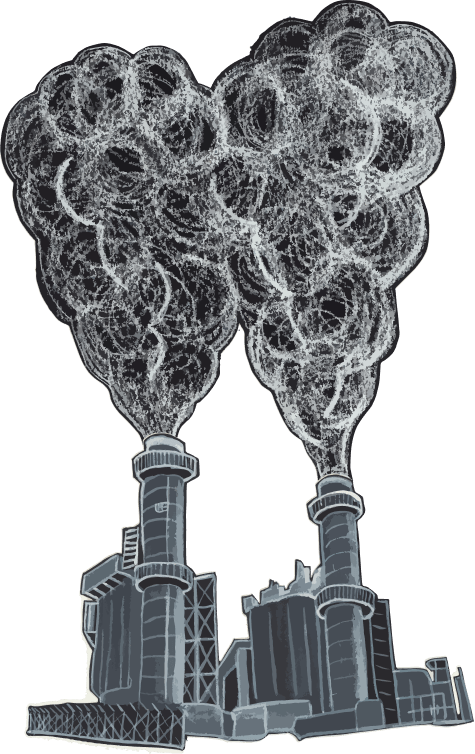Illinois
Back to mapTo get to zero by 2050, Illinois must cut emissions by 3.8% a year
Emissions in Illinois
Million metric tons of carbon dioxide (CO2) equivalent (MTCO2e
) emissions
Note: Grey area indicates missing data due to processing delays.
Source: WRI, Mar 2021
This is how we're going to do it
- Boilers and furnaces with heat pumps
- Gas stoves with electric induction stoves
- No-till farming to keep CO2 in the soil
- Capturing methane leaks from landfills
- Capturing CO2 to make emissions-free concrete
- Burning green hydrogen to make emissions-free steel
- Plugging methane leaks from gas pipelines
Decarbonize Our Buildings
15% of Illinois's climate pollution comes from buildings.
We burn fossil fuels to heat our air, water, and food.
To cut this pollution...
Let's electrify our heat!
We'll replace...
...in all of Illinois's 5.2 million buildings.
In fact, 20.0% of appliances in buildings in Illinois are already fossil fuel free!
That means we only need to electrify the remaining 4.2 million dirty buildings in Illinois. That's around 158,000 per year.
Source: Microsoft, Mar 2021; NREL, Dec 2021Electrifying all buildings cuts 15% of the pollution.
Decarbonize Our Transport
26% of Illinois's pollution comes from cars, trucks, trains, and planes.
But mostly from cars.
To cut this pollution,
your next car must be electric.
Or consider going car-free with public transit, bikes/e-bikes, car share, or other alternatives!
There are 4.2 million vehicles in Illinois and 26,000 are already electric (0.6% of the total).
We need to electrify (or replace) the remaining 4.1 million gas-powered vehicles. That's around 157,000 a year.
Source: DOT, Feb 2021Electrifying all transportation cuts 26% of the pollution.
Decarbonize Our Power
24% of Illinois's pollution comes from burning coal, gas, and oil to make power.

That's because of how power is generated in Illinois today.
Power Generation in the State of Illinois (2020)
But there's already 67% carbon-free electricity generation in Illinois!
To clean up the emissions from the polluting power plants we need to replace all fossil fuel power plants with solar and wind farms.

...and find good jobs for those workers.
Current Fossil Fuel Power Plants in Illinois
19 coal plants
1,894 MW
1,786 MW
1,766 MW
1,319 MW
1,269 MW
1,235 MW
1,100 MW
1,005 MW
915 MW
780 MW
718 MW
618 MW
441 MW
422 MW
335 MW
306 MW
65 MW
55 MW
5 MW
65 gas plants
1,728 MW
1,320 MW
1,256 MW
1,098 MW
1,086 MW
995 MW
726 MW
702 MW
692 MW
692 MW
684 MW
641 MW
628 MW
611 MW
540 MW
508 MW
483 MW
456 MW
416 MW
407 MW
380 MW
356 MW
353 MW
316 MW
313 MW
302 MW
270 MW
270 MW
213 MW
188 MW
173 MW
168 MW
139 MW
83 MW
71 MW
64 MW
60 MW
38 MW
33 MW
32 MW
30 MW
27 MW
19 MW
18 MW
12 MW
11 MW
11 MW
8 MW
7 MW
7 MW
7 MW
6 MW
6 MW
5 MW
5 MW
4 MW
4 MW
4 MW
4 MW
4 MW
4 MW
3 MW
3 MW
3 MW
2 MW
25 oil plants
663 MW
46 MW
30 MW
27 MW
25 MW
20 MW
19 MW
18 MW
18 MW
17 MW
17 MW
16 MW
15 MW
13 MW
11 MW
9 MW
9 MW
8 MW
7 MW
5 MW
5 MW
5 MW
5 MW
4 MW
4 MW
But wait!
It's not enough to replace our power plants with wind and solar farms.
To power our electric cars and buildings, we need two times the electricity we have today.
In all, we'll need to build 12,000 megawatt (MW) of wind power and 11,000 MW of solar power.
Since the average wind turbine provides 2.75 MW of peak capacity, Illinois would need to install about 5,000 turbines.
Since Illinois already has 2,000 MW of wind and 165 MW of solar, that's 10,000 MW of wind power we need to build and 11,000 MW of solar power. That's around 398 MW of wind power and 422 MW of solar power a year.
Source: EIA, Apr 2022Decarbonizing all dirty power cuts 24% of the pollution.
And gives us zero-emissions power we need to eliminate pollution from buildings and cars!
Other Emissions
The last 34% of Illinois's climate pollution comes from other sources...
This includes farming, landfills, industry, and leaks from gas pipelines.
There's no one solution to solve these problems, but there are lots of great ideas:
That doesn't mean there's no solution, it just means that clean electrification doesn't help with these problems, and you could fill a whole book with covering all of them. We need to encourage our politicians to invest in researching new solutions and implementing existing solutions to these problems!
Ready to do your part?
Learn how to electrify your own machines and pass local policy to electrify the rest
Take Action